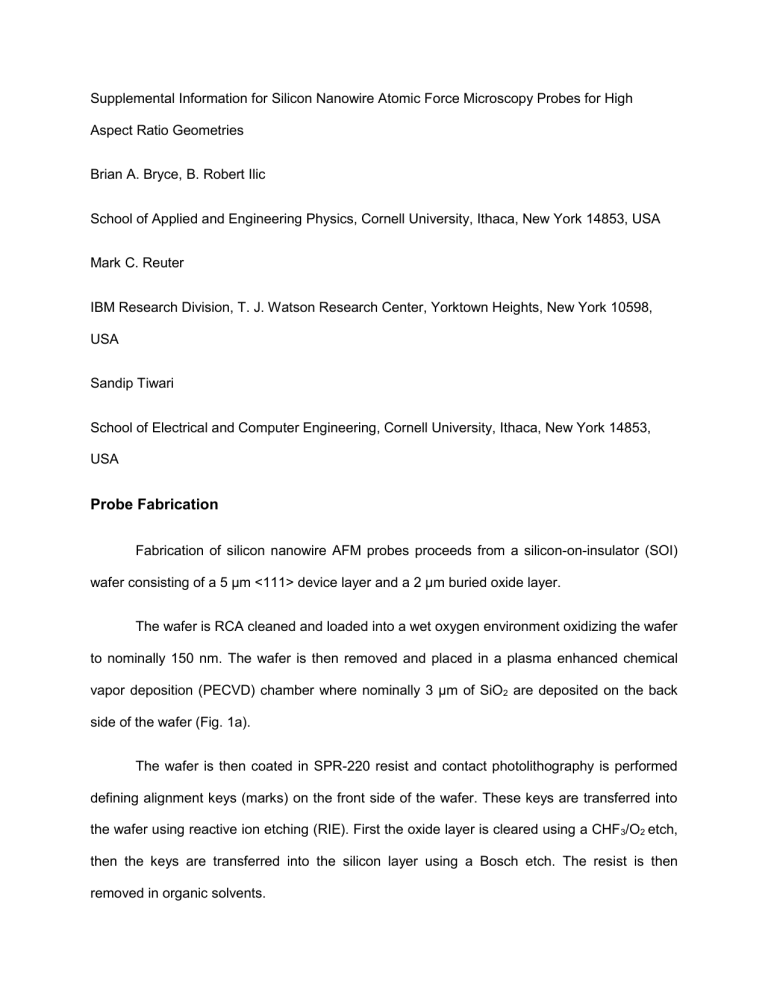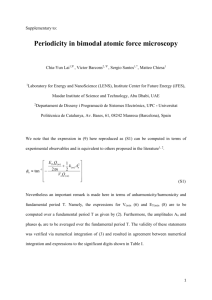supNWAFMprobeAPL

Supplemental Information for Silicon Nanowire Atomic Force Microscopy Probes for High
Aspect Ratio Geometries
Brian A. Bryce, B. Robert Ilic
School of Applied and Engineering Physics, Cornell University, Ithaca, New York 14853, USA
Mark C. Reuter
IBM Research Division, T. J. Watson Research Center, Yorktown Heights, New York 10598,
USA
Sandip Tiwari
School of Electrical and Computer Engineering, Cornell University, Ithaca, New York 14853,
USA
Probe Fabrication
Fabrication of silicon nanowire AFM probes proceeds from a silicon-on-insulator (SOI) wafer consisting of a 5 µm <111> device layer and a 2 µm buried oxide layer.
The wafer is RCA cleaned and loaded into a wet oxygen environment oxidizing the wafer to nominally 150 nm. The wafer is then removed and placed in a plasma enhanced chemical vapor deposition (PECVD) chamber where nominally 3 µm of SiO
2
are deposited on the back side of the wafer (Fig. 1a).
The wafer is then coated in SPR-220 resist and contact photolithography is performed defining alignment keys (marks) on the front side of the wafer. These keys are transferred into the wafer using reactive ion etching (RIE). First the oxide layer is cleared using a CHF
3
/O
2 etch, then the keys are transferred into the silicon layer using a Bosch etch. The resist is then removed in organic solvents.
The backside of the wafer is coated in SPR-220 resist and contact lithography is performed defining windows around the body of each AFM probe (Fig. 1b). These windows amount to the negative body of the AFM probes inside a bounding box. This pattern is transferred through the thick PECVD oxide on the backside of the wafer using a CHF
3
/O
2
RIE.
Alternatively hydrofluoric acid (HF) can be used to clear the back oxide layer. Following this the resist is removed in organic solvents.
The front side of the wafer is then coated in SPR-200 resist and the cantilever pattern is defined using contact lithography. This pattern is transferred only half way through the oxide layer. This allows the alignment of the next step to be checked locally to ensure there are no gross errors. This step would not be needed for mass production. The resist is then removed in organic solvents.
The front side of the wafer is coated in SPR700 resist. 1 µm dots are defined at the tip of each cantilever using an i-line stepper. The pattern alignment can be optically checked locally to the cantilever pattern assuming the prior step is carried out, otherwise it can be difficult to find the pattern. This pattern is transferred half way through the oxide layer using a CF
4
RIE. The remainder of the oxide layer is cleared in a buffered oxide etch (BOE) 30:1 solution. A 100:1 HF solution is then used followed by a DI rinse. This leaves a pristine hydrogen terminated silicon surface under and undercut SPR-700 liftoff mask (Fig. 1c).
The wafer is immediately loaded into an evaporation chamber after being dried with N
2
.
The chamber is pumped to a pressure less than 2x10 -6 Torr and Au is evaporated at a rate of 2-
3 Å/s to a thickness of 50-100 nm. The wafer is removed from the chamber and liftoff is performed in N-Methyl-2-pyrrolidone (NMP) . This leaves a 1 µm Au dot inside a larger SiO
2
well
(Fig. 1d).
SPR-220 is then spun on the front side of the wafer and the cantilever pattern is defined using contact lithography. The resist is baked overnight in an oven at 90 C. The pattern is transferred fully through the oxide layer (Fig. 1e). The pattern is then transferred through the device layer using a Bosch etch. This etching stops on the BOX layer (Fig. 1f).
Following this step the side of the 150 nm front side oxide is exposed. To cover this layer
SPR-220 is again spun on the front side without removing the previous resist layer. In order to ensure the solvent is removed from the film, the resist is baked overnight in an oven at 90 C
(Fig. 1g). Residual solvent during one of the subsequent deep silicon RIE steps will cause the resist film to bubble thereby compromising the etch masking of the resist.
The wafer is then placed with face down in a Bosch etcher and the body of the probes are transferred using the oxide mask defined earlier (Fig. 1h). This etching stops on the BOX layer. The front side resist provides further mechanical support to the thin BOX layer during this step.
The wafer is then placed in HF and the BOX layer is removed. Following this the resist is removed in organic solvents. This results in a released cantilever structure with Au dots inside oxide wells (Fig. 1i).
These oxide wells can be used to confine Au migration if desired. However if Au comes in contact with a thick oxide layer it can be pinned at the contact point. This can lead to undesirable kinking effects that will cause wires to not grow vertically. At typical temperatures used in SiH
4
reactors this oxide layer is not essential and yield of vertical wires can be better without it particularly in the case of large arrays of wires. Annealing at high temperatures or for long times can also improve vertical yield.
For the wires grown in these experiments we choose to completely strip the oxide layer in HF prior to wire synthesis. This is done in an HF 10:1 solution. This leaves an isolated Au dot on a hydrophobic Si surface (Fig. 1j).
After the HF step the wafer is immediately loaded into a turbo pumped loadlock. Once the loadlock is pumped the wafer is transferred into a main chamber of a UHV CVD reactor. The temperature of the main chamber is 600 C. The sample is allowed to equilibrate and anneal in
UHV for 5 minutes at which point pure SiH
4
is flowed. The chamber is pressurized to 250 mTorr.
In this atmosphere the wires nucleate and grow. The time determines the wire length. A typical growth time is 10-30 minutes.
The wafer is then removed from the chamber into the loadlock and cooled under vacuum. After this the probes may be broken out and used or thinning if desired. The nominal diameter of a nanowire grown by the process described is natively 250-400 nm.
To thin a probe the Au tip should first be removed. To do this the sample is dipped in HF to remove any oxide over-layers then carefully rinsed in DI water. Following this the Au is removed in KI/I
2
solution, rinsed in DI then HCl then DI. It is essential to completely remove all iodine from the sample before oxidation as it greatly enhances oxidation of silicon.
The sample can then be oxidized in a dry or wet oxygen furnace. This oxide layer can then be removed using a vapor HF chamber. The diameter of the resulting AFM tip is governed by the oxidation thickness and the initial wire diameter.
Additional AFM Data
The nanowire probe used for the images uses in Fig. 3 of the main paper was initially thinned to a diameter of 244 nm. At this diameter trenches of progressively smaller width were scanned until the bottom of the trench structure was no longer
reachable. For the 244 nm diameter trenches as narrow as 500 nm could be probed, however it was not possible to reach the bottom of a 400 nm wide trench (Fig. 3). By thinning the probe to a diameter of 84 nm trenches as narrow as 300 nm could be probed as noted in the main letter text.
Fig. 1. (Color online) Schematic representation of the process flow for AFM probe fabrication
(not to scale). In the figures blue is SiO
2
, gray is Si, Gold is Au, and tan is resist. After the creation of the main layer stack (a), the backside window is defined (b), the nanowire catalyst site is defined (c), Au is evaporated and lifted off (d), the cantilevers are defined in the device layer (e) and (f), and the cantilevers are released (h) and (i). Finally the top oxide is stripped just before wire growth (not shown). After growth the probe is then complete and can be used.
Fig. 2. (Color online) An example nanowire AFM probe after the complete process including thinning (scale bar: 5 µm). The thinned wire tip is highlighted in yellow against the blue cantilever. The smooth area around the wire tip is a result of Au migration during the growth which changes the CVD morphology. The wire shown is nominally 50 nm at the tip and 8 µm long.
Fig 3. (Color online) (a) A SEM of 500 nm wide trenches of depth 2 µm (scale bar 2 µm).
(b) An AFM line trace made by the same method used in Fig. 2 and 3 in the main paper of the 500 nm wide trenches using the probe from Fig. 3 of the main paper with a diameter of 244 nm at the time of imaging. The probe reaches the bottom of the trench in the central portion of the AFM trace. (c) 400 nm wide trenches of depth 2 µm (scale bar 2 µm).
(d) An AFM line trace of the 400 nm trenches shown in (c). The probe is not able to reach the bottom of the trench structure.






